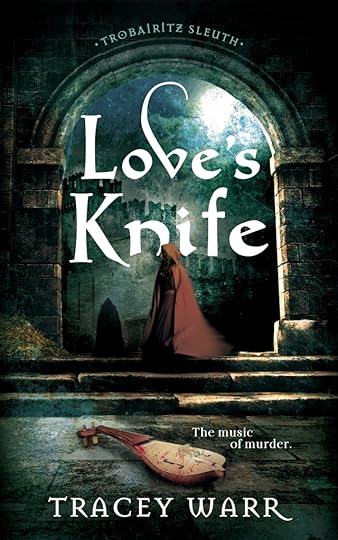Tracey Warr's Blog, page 4
September 3, 2024
A busy week: New book, historical fiction conference
Rebekah Simmers interviewed me about organising the HNS UK 2024 conference, which is taking place this weekend in Devon, UK (online tickets are available) and about the publication (yesterday) of my latest medieval novel – my sixth.
http://hns2024.com/2024/09/02/conference-interview-tracey-warr/
What next? After the conference, I’m looking forward to a short period of being a slacker! Doing not much for as long as I can (which won’t be long) – hanging with my friends and family. The next writing project is a biography of three medieval sisters who ruled in Southern France and Catalonia. I’m looking forward to getting back to the work on that.
Cover image: 8th-century Witham pin in the British Museum. A silver gilt, triple pin disc brooch to hold together a cloak or dress. It was one of the key starting points for my new novel, Love’s Knife. I am often set off writing by an object or image.
September 2, 2024
Book Launch Interview with the HNS
Launch: Tracey Warr’s Love’s Knife
The cover image shows salt mounds at Aigues-Mortes. The medieval salt trade features in the novel.
Books – special offer!
Continuing to celebrate publication day, there is a special offer at the end of this interview:
Launch: Tracey Warr’s Love’s Knife
The cover image shows salt mounds at Aigues-Mortes. The medieval salt trade features in the novel.
Publication Day! – Love’s Knife
It is publication day for my new novel, Love’s Knife, a medieval murder mystery set in Toulouse at the turn of the 12th century.
Tony Riches has a guest post from me on his blog on writing the novel:
https://tonyriches.blogspot.com/2024/09/book-launch-guest-post-by-tracey-warr.html
The book is available now as an ebook and paperback.
Love’s Knife is on Kindle Unlimited for the next 90 days. If you aren’t already receiving posts from me, you can follow me here and/or sign up to my quarterly newsletter to get news of other deals. http://eepurl.com/ifTA_P
August 31, 2024
Historical Novelists Converge
I have been busy for the last two years organising the Historical Novel Society UK 2024 conference, which has a stellar lineup of speakers and events, including Diana Gabaldon, Bernard Cornwell, S.G. MacLean, Ian Mortimer, Kate Quinn, Jane Johnson, Elizabeth Chadwick, Elizabeth Fremantle and many more. The conference is just around the corner now – 5-8 September at Dartington Hall in Devon. The onsite conference is sold out, but online tickets are still available:
https://historicalnovelsocietyuk.regfox.com/online
Thanks to Helen Hollick for her post on conference attendee books, which features my novel, The Viking Hostage:
https://ofhistoryandkings.blogspot.com/2024/08/my-hns-conference-uk-guest-authors-cc.html
July 22, 2024
Becoming Trobairitz
This week, The Occitan University was in my home village of Laguepie in southern France for its annual visit. The university consists of a packed week of Occitan language classes and workshops and events on Occitan culture, including cooking, dancing, music, history, literature, and radio. The week culminated in a magical street party of impromptu singing, music and dancing.
I was invited to present a workshop over two mornings on learning to be a troubadour or trobairitz (female troubadour) and to give a presentation at the castle on three medieval Occitan female lords.
With workshop participants, Veronique Gaumont, Florence Poret, Tiffany Black, Christine Hopps and Anne Mylan, and colleague, Armandine Rey, we wrote our own vidas (boastful troubadour biographies), cansos (love songs), and tensos (debate songs). The group came up with some fabulous and funny poetry, which was performed at the castle, with lovely harp playing from Veronique and Florence on accordion. A Troubadour Playlist and suggested Further Reading here.
Become a Trobairitz Workshop SourcesDownloadAs darkness fell, I presented a talk on the 11th-century La Marche sisters, Almodis, countess of Toulouse and Barcelona; Rangarde, countess of Carcassonne; and Lucia, countess of Pallars Sobira. My presentation was opened and closed with two songs by the troubadour duke, Guillaume d’Aquitaine, performed by Amandine Rey. The castle on its rocky outcrop overlooking the valley and the Viaur river was a spectacular venue for the beautiful power of Amandine’s voice.
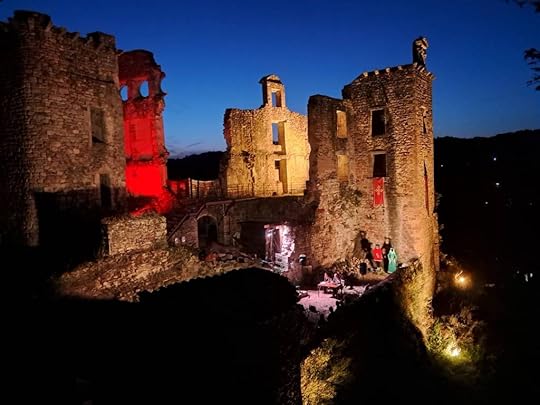
Guillaume d’Aquitaine and a trobairitz are characters in my new novel, Love’s Knife, published on 2 September and on preorder now.
Thanks to Tom for the photo and to Carlos for the rehearsal venue.
Three Female Lords SourcesDownloadInto the Map Workshop
I am presenting Into the Map, a writing workshop, tomorrow in the village of Laguepie 82250 France at Tresors du Viaur, Tuesday 23 July 10.30am-12.30pm.
Robert Louis Stevenson tells us that ‘even when a map is not all the plot … it will be found to be a mine of suggestion.’
We will be looking at how studying maps and plans, researching local history, and treading the ground of your setting can help you develop a story. Certain scenes and events can happen because of the layout of a place, because you can imagine moving through that place with your characters.
Peter Turchi (2004) Maps of the Imagination: The Writer as Cartographer, San Antonio, Texas: Trinity University Press is a key resource, and see:
Tracey Warr (2016) ‘The Lure of Another Place and Time: The Landscape and History of France’, Historical Novels Review, February, 75. Available at: https://historicalnovelsociety.org/the-lure-of-another-place-time-the-landscape-history-of-france/.
Contact traceykwarr@gmail.com if you would like to join the workshop. Cost: 10 euros.
July 3, 2024
Be Your Own Troubadour

Be Your Own Troubadour
with Tracey Warr and Amandine Rey
Thursday 18 July and Friday 19 July
10am-12 noon
Salle des Fetes, Laguépie 82250
In French, English and Occitan
Create your own troubadour vida (introductory, often boasting autobiography) and tenso (debate song, usually between a man and a woman about love) or canso (love song).
You can write or sing or both. You don’t need to be an expert. Gaiety is the aim.
60 euros
Contact: traceykwarr@gmail.com
June 30, 2024
The Spy’s Daughter

I’m very pleased to welcome historical fiction author Tony Riches as a guest to my blog today.
Tony is an author of best-selling historical fiction. He lives in Pembrokeshire, West Wales and is a specialist in the history of the Wars of the Roses and the lives of the Tudors. He is best known for his Tudor trilogy, and is now completing his Elizabethan series.
He runs a popular podcast series, Stories of the Tudors.
His new novel, Frances: Tudor Countess, has just been published. Based on extensive research, original letters and records of the Elizabethan Court, this new account explores the life of Frances Walsingham, the only surviving child of Queen Elizabeth’s ‘spymaster’ Sir Francis Walsingham.
Better educated than most men, her father arranges her marriage to warrior poet Sir Philip Sidney. After Philip is killed in battle, Frances becomes Countess of Essex, and is banished from court after her second husband Sir Robert Devereaux’s rebellion against the queen. In her third marriage, can she marry for love, if it means turning her back on her faith and all she knows?
The story follows Frances, Countess of Essex and Clanricarde, from her first days at the Elizabethan court to the end of the Tudor dynasty and the rise of the Stuarts.
I interviewed Tony about his new book:
Why did you choose to write about Frances?
I decided to make the Elizabethan books a series of six, rather than a trilogy, and explore the complexity of Queen Elizabeth through the eyes of three of her favourite men, Drake, Essex and Raleigh, and three of her ladies. I had plenty of ladies to choose from, but found the most interesting were Penelope, eldest daughter of the queen’s nemesis, Lady Lettice Knollys, one of her ‘gentlewomen’, Bess Raleigh, and Frances, the only surviving child of the queen’s spymaster, Sir Francis Walsingham.
I had already researched Frances when writing my book about her second husband, Robert Devereux, Earl of Essex, and was intrigued to learn Frances nursed her father through illness at his home, Walsingham House, in the shadow of the Tower of London. Unusually for the time, Sir Francis ensured his daughter had the best education he could afford, and spent long hours tutoring her himself in Latin, French and Spanish.
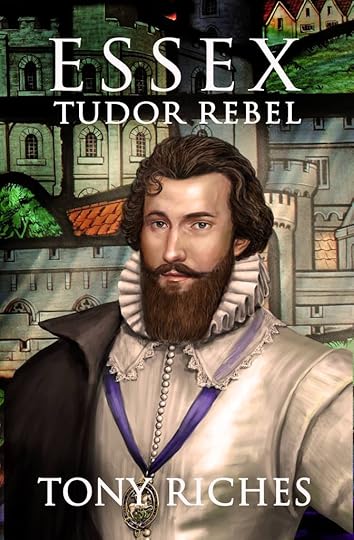
Can you tell us something about how and where you do your research for your novels and for this one in particular?
Over the past ten years I’ve built an extensive reference collection of books on everything Tudor and Elizabethan, from medicine to recipes, childbirth to government, as well as numerous biographies of key players in the story of the Tudors. All this research provides the backdrop within which the real lives and relationships of my chosen subjects develop and evolve.
One of my favourite historical sources for the Elizabethan series is The Elizabethan Court Day by Day by Marion E. Colthorpe.
A rich and varied collection of research, this is where I discovered such details as the queen’s chambers being infested with fleas, the lists of participants in Accession Day jousts, and actual menus for royal banquets. Most importantly, this resource enabled me to cross-check events on any day at the Elizabethan court with other sources to ensure historical accuracy.
How did her father’s career as ‘spymaster’ affect her? Did she have anything of the spy in her?
The queen was unsympathetic about her spymaster’s illness, and concerned about Catholic plots. His problem was knowing who he could trust, as he even suspected members of his own network of being double agents. It is therefore likely that he would turn to the one person he could rely on, his daughter Frances.
In my book, Frances works in her father’s study, decoding the latest letters of intelligence from their agents. The work takes patience, yet she finds the challenge satisfying. Her ability to memorise and recall the detail of codes means she can decipher faster than her father. She enjoys helping him, and being the first to know important state secrets.
She was married to two fascinating men Philip Sidney and Robert Devereaux. Can you tell us something about those relationships?
Her father arranged her marriage to Philip Sidney, and paid off his debts, so he must have seen something in the warrior poet (who was in love with Frances’ friend, the beautiful, charismatic and wealthy Baroness Penelope Rich, the subject of my previous book).
Robert Devereux had his pick of the wealthy heiresses at court, yet chose to marry Frances. We can never know for certain, but I suspect Robert promised the dying Philip, his best friend and mentor, that he would take good care of his wife and young daughter Elizabeth.
Are any of Sidney’s poems inspired by Frances?
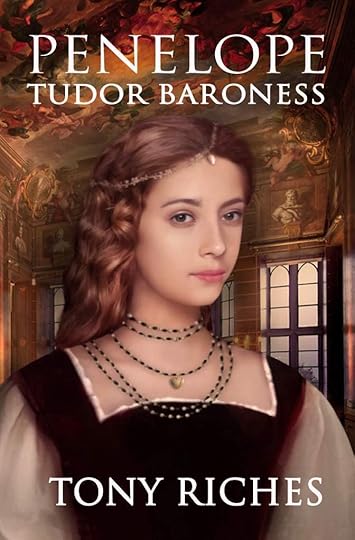
I studied Philip Sidney’s poetry in hope of finding something about Frances, but it must have been evident to her that the subject of her husband’s poetry was his ‘Stella’, his code name for Penelope Rich. Frances was a realist, and remained a lifelong friend to Penelope (who became her sister-in-law when Frances married Robert Devereux).
Any other fascinating elements of the novel you’d like to mention for us?
An unexpected development comes after the Essex rebellion, when Frances meets her third husband and becomes an Irish countess. I’d studied the English occupation of Ireland for previous books in the Elizabethan series, but found it interesting to look at events from the Irish point of view.
Frances could have remained at her mansion in London or her new estate in Kent, but chose to live with her family in the draughty castle in Athlone to be close to her husband, who’d been made governor of Connaught. I created the character of Orla Ryan, the bright young daughter of a prosperous Galway merchant, to represent the local servants Frances would have employed, and from whom she learns about the Irish language and culture.
Are there any particular sites or artefacts that you used in your writing to conjure up your story?
I tracked down examples of the ciphers Frances could have worked on:
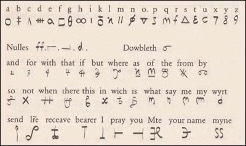
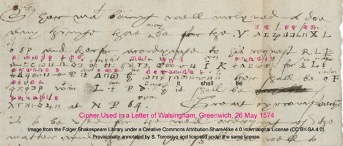
Frances could have helped her father decode letters from Mary Queen of Scots, and provide evidence of the Babington plot, as well as the first warnings of the Spanish Armada. Unlike the substitution tables favoured by Catholics, her father used symbols, over and under the same letters, to change their meaning. For example, a letter ‘m’ with two dots below means ‘more’, and ‘m’ with a bar across the top means ‘money’. The queen and many others had their own secret symbols, meaningful only to Frances, her father and his most trusted agents.
I also found a painting by J M W Turner of the mansion house at Somerhill, in Tonbridge, Kent, which was built for Frances by her third husband:
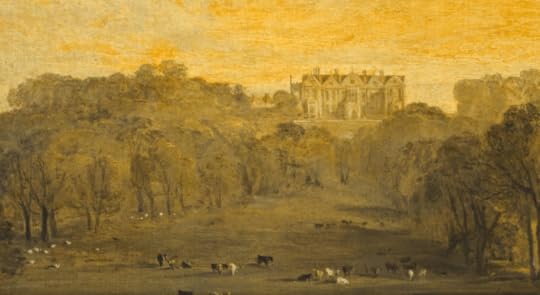 Somerhill by J M W Turner (Creative Commons)
Somerhill by J M W Turner (Creative Commons)Somerhill is now a private school, but as well as original architectural details, Turner’s painting was invaluable for understanding how the building dominated the landscape. I also found the original plans for Portumna Castle in Ireland, which helped make it an authentic setting for events in the book.
What’s next for you?
I am now working on the research for the sixth and final book in the Elizabethan series, about another underestimated woman, Bess Raleigh. When I set out on this ‘journey’ to tell the story of the Tudors I had no idea how much I would learn about fascinating women, such as Frances Walsingham, who witnessed the key events of the Elizabethan era first-hand, yet is so little known – until now.
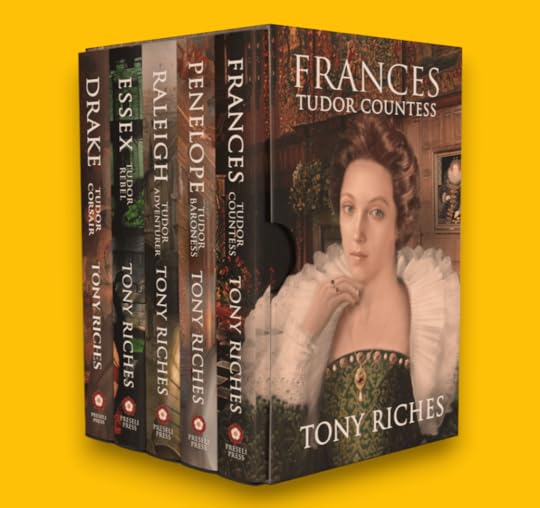
Thank you very much for talking with me, Tony, and for bringing these characters from history so vividly to life for readers.
Frances – Tudor Countess is new from Amazon in eBook and Paperback, and an audiobook edition will be produced this year:
 https://www.amazon.co.uk/dp/B0D1YQYL8
https://www.amazon.co.uk/dp/B0D1YQYL8
 https://www.amazon.com/dp/B0D1YQYL8G
https://www.amazon.com/dp/B0D1YQYL8G
Links:
Website: https://www.tonyriches.com/
Twitter: https://twitter.com/tonyriches
Bluesky: https://bsky.app/profile/tonyriches.bsky.social
Facebook: https://www.facebook.com/tonyriches.author/
LinkedIn: https://www.linkedin.com/in/tonyriches/
Instagram: https://www.instagram.com/tonyriches.author/
Amazon Author Page: https://www.amazon.com/Tony-Riches/e/B006UZWOXA
Goodreads: https://www.goodreads.com/author/show/5604088.Tony_Riches
June 22, 2024
Love’s Knife
I have been serialising my new novel, Love’s Knife, on Substack for £5 a month for paying subscribers, with a chapter published every Saturday. It’s not too late to join in reading. You can review the chapters and cast of characters on the Hub post. Subscribers receive a free paperback or ebook (which can be gifted) when the story completes in August.
Love’s Knife is a medieval murder mystery set in Toulouse at the end of the 11th century. Beatriz is a trobairitz (a female troubadour) in the entourage of Philippa of Tolosa. A brutal murder occurs and she must solve the crime to prevent a great injustice.
Love’s Knife is published on 2 September and is on preorder now.
